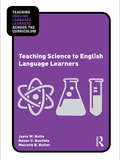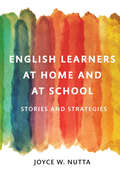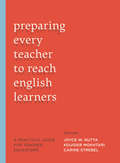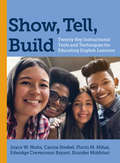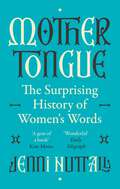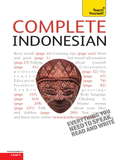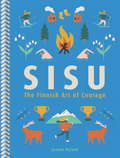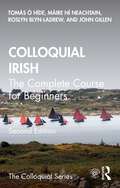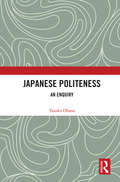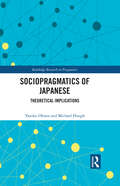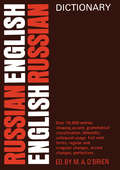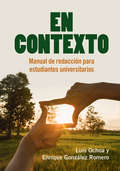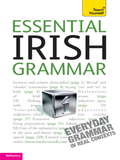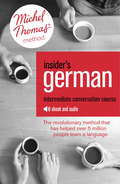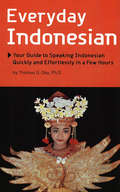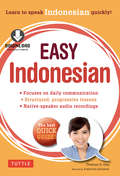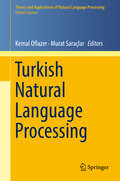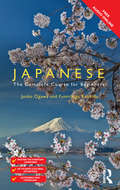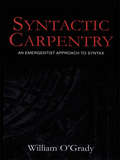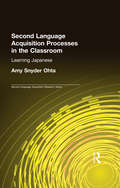- Table View
- List View
Teaching Science to English Language Learners
by Joyce Nutta Nazan U. Bautista Malcolm B. ButlerBooks in the Teaching English Language Learners (ELLs) across the Curriculum Series are written specifically for pre- and in- service teachers who may not have been trained in ELL techniques, but still find themselves facing the realities and challenges of today's diverse classrooms and learners. Each book provides simple and straightforward advice on how to teach ELLs through a given subject area, and how to teach content to ELLs who are at different levels of English language proficiency than the rest of their class. Authored by both language and content area specialists, each volume arms readers with practical, teacher-friendly strategies, and subject-specific techniques. Teaching Science to English Language Learners offers science teachers and teacher educators a straightforward approach for engaging ELLs learning science, offering examples of easy ways to adapt existing lesson plans to be more inclusive. The practical, teacher-friendly strategies and techniques included here are proven effective with ELLs, and many are also effective with all students. The book provides context-specific strategies for the full range of the secondary sciences curriculum, including physical science, life science, earth and space science, science as inquiry, and history and nature of science and more. A fully annotated list of web and print resources completes the book, making this a one volume reference to help science teachers meet the challenges of including all learners in effective instruction. Special features: practical examples of science exercises make applying theory to practice simple when teaching science to ELLs an overview of the National Science Education Standards offers useful guidelines for effective instructional and assessment practices for ELLs in secondary grades graphs, tables, and illustrations provide additional access points to the text in clear, meaningful ways.
English Learners at Home and at School: Stories and Strategies
by Joyce W. NuttaThe engaging profiles of English Learners at Home and at School offer access to a deeper and broader understanding of the lived experiences of English learners and their families. Such knowledge is essential for all educators in order to anticipate the needs of, and best support, English learners.In this highly readable volume, Joyce W. Nutta helps to build the bridge of knowledge and empathy between teachers and the English learners they support. In an inspired approach to the topic, she presents six compelling portraits of English learners who come from different cultural backgrounds and who are at different points in their educational journeys, from preschool to community college. Informed by real-life observations, extensive interviews, and academic research, these lively portrayals highlight issues and concerns that commonly arise in multicultural and multilingual learning and teaching.Nutta accompanies each profile with details on the specific cultural, linguistic, and educational factors at play and offers sound practical guidance for supporting English learner achievement in classrooms. She suggests educational strategies, including establishing dual-language classrooms, adapting instruction, and inviting parent participation, that can scaffold English learners&’ academic success.English Learners at Home and at School will help educators develop a better awareness of all their students—even those who come from backgrounds vastly different from their own.
Preparing Every Teacher to Reach English Learners: A Practical Guide for Teacher Educators
by Joyce W. Nutta Kouider Mokhtari Carine Strebel2013 Outstanding Book Award, American Association of Colleges for Teacher Education (AACTE)Preparing Every Teacher to Reach English Learners presents a practical, flexible model for infusing English learner (EL) instruction into teacher education courses. The editors outline the key steps involved in this approach—winning faculty support, assessing needs, and developing capacity—and share strategies for avoiding pitfalls. The central chapters feature sample courses illustrating how EL content can be incorporated into standard courses (human development, learning disabilities, and social foundations) and across subject areas and topics (math, science, social science, physical education, and classroom management). Most preservice teacher candidates report that they feel unprepared to work with English learners. This practical, flexible model for infusing EL content into teacher education will provide an invaluable resource in shaping the next generation of teachers.
Show, Tell, Build: Twenty Key Instructional Tools and Techniques for Educating English Learners
by Joyce W. Nutta Carine Strebel Florin M. Mihai Edwidge Crevecoeur Bryant Kouider MokhtariBuilding upon the theoretical and practical foundation outlined in their previous book, Educating English Learners, the authors show classroom teachers how to develop a repertoire of instructional techniques that address K–12 English learners (ELs) at different English proficiency and grade levels, and across subject areas. Show, Tell, Build is organized around two decision maps for planning and implementing differentiated instruction for ELs: the Academic Subjects Protocol (for teachers of academic subjects) and the Language Arts Protocol (for teachers of language arts). The instructional tools and techniques described in each chapter help teachers provide communication support for ELs through showing and telling, and develop their language proficiency through building their skills. The book also discusses the demands that academic language poses for ELs and ways to assess students&’ proficiency in English. Show, Tell, Build provides classroom teachers, English language development specialists, literacy coaches, and school leaders with valuable knowledge and skills to support ELs&’ academic success.
Mother Tongue: The surprising history of women's words -'Fascinating, intriguing, witty, a gem of a book' (Kate Mosse)
by Jenni NuttallA rich, provocative and entertaining history of women's words - of the language we have, and haven't, had to share our lives.'Fascinating, intriguing, witty, a gem of a book' KATE MOSSE'Full of interesting observations ... Entertaining' PHILIP HENSHER, SPECTATOR'This superb book teems with historical marvels and their 21st century resonances.' REBECCA WRAGG SYKES, author of KindredSo many of the words we use to articulate the experiences women share feel awkward or alien. Medical terms are accurate but antiseptic. Slang often perpetuates stereotypes. Where are the plain, honest words for women's daily lives? From the dawn of Old English to the present day, Dr. Jenni Nuttall guides readers through the evolution of the words we have used to describe bodies, menstruation, sexuality, the consequences of male violence, childbirth, paid and unpaid work, and gender.Along the way, she argues that, paradoxically, as women have made slow progress towards equality, we've lost some of the most expressive and eloquent bits of our vocabulary. Inspired by Nuttall's deep knowledge of the English language as well as conversations with her teenage daughter, this is a book for anyone who loves language - and for feminists who want to look to the past in order to move forward.'There is a nugget of joy and wisdom on every single page' VICTORIA WHITWORTH, historian and author of Daughter of the Wolf
Complete Indonesian Beginner to Intermediate Course: Learn to read, write, speak and understand a new language with Teach Yourself
by Eva Nyimas Christopher ByrnesAre you looking for a complete course in Indonesian (Bahasa Indonesia) which takes you effortlessly from beginner to confident speaker? Whether you are starting from scratch, or are just out of practice, Complete Indonesian (Bahasa Indonesia) will guarantee success!Now fully updated to make your language learning experience fun and interactive. You can still rely on the benefits of a top language teacher and our years of teaching experience, but now with added learning features within the course and online. The course is structured in thematic units and the emphasis is placed on communication, so that you effortlessly progress from introducing yourself and dealing with everyday situations, to using the phone and talking about work. By the end of this course, you will be at Level B2 of the Common European Framework for Languages: Can interact with a degree of fluency and spontaneity that makes regular interaction with native speakers quite possible without strain for either party.Learn effortlessly with a new easy-to-read page design and interactive features: NOT GOT MUCH TIME?One, five and ten-minute introductions to key principles to get you started.AUTHOR INSIGHTSLots of instant help with common problems and quick tips for success, based on the author's many years of experience.GRAMMAR TIPSEasy-to-follow building blocks to give you a clear understanding.USEFUL VOCABULARYEasy to find and learn, to build a solid foundation for speaking.DIALOGUESRead and listen to everyday dialogues to help you speak and understand fast.PRONUNCIATIONDon't sound like a tourist! Perfect your pronunciation before you go.TEST YOURSELFTests in the book and online to keep track of your progress.EXTEND YOUR KNOWLEDGEExtra online articles at: www.teachyourself.com to give you a richer understanding of the culture and history of Indonesia.TRY THISInnovative exercises illustrate what you've learnt and how to use it.
Complete Indonesian Beginner to Intermediate Course: Learn to read, write, speak and understad a new language with Teach Yourself
by Eva Nyimas Christopher Byrnes Eva NjmasAre you looking for a complete course in Indonesian (Bahasa Indonesia) which takes you effortlessly from beginner to confident speaker? Whether you are starting from scratch, or are just out of practice, Complete Indonesian will guarantee success!Fully updated to make your language learning experience fun and interactive, with complete online audio support. You can still rely on the benefits of a top language teacher and our years of teaching experience, but with added learning features within the course.The course is structured in thematic units and the emphasis is placed on communication, so that you effortlessly progress from introducing yourself and dealing with everyday situations, to using the phone and talking about work. By the end of this course, you will approach Level B2 of the Common European Framework for Languages: Can interact with a degree of fluency and spontaneity that makes regular interaction with native speakers quite possible without strain for either party.Learn effortlessly with a new easy-to-read page design and interactive features: NOT GOT MUCH TIME?One, five and ten-minute introductions to key principles to get you started.AUTHOR INSIGHTSLots of instant help with common problems and quick tips for success, based on the author's many years of experience.GRAMMAR TIPSEasy-to-follow building blocks to give you a clear understanding.USEFUL VOCABULARYEasy to find and learn, to build a solid foundation for speaking.DIALOGUESRead and listen to everyday dialogues to help you speak and understand fast.PRONUNCIATIONDon't sound like a tourist! Perfect your pronunciation before you go.TEST YOURSELFTests in the book and online to keep track of your progress.TRY THISInnovative exercises illustrate what you've learnt and how to use it.AUDIOAccess the audio for this course for free by downloading it to the Teach Yourself Library app or streaming it on library.teachyourself.com
Sisu: The Finnish Art of Courage
by Joanna NylundDiscover the Finnish quality of sisu and how cultivating it can help you lead a life of greater purpose and happiness.This ancient Finnish word describes an attitude of courage, resilience, grit, tenacity and perseverance. This key psychological competence enables extraordinary action in times of adversity. To have sisu confers a further dimension of doing so with honesty, integrity and humility.By cultivating sisu you can: Face life's challenges with courage and determination Enhance your wellbeing and find your focus Communicate confidently and resolve conflicts effectively Cultivate endurance and achieve your fitness goals Raise kind and resilient children Act with integrity and fight for what you believe inSisu is a universal trait. It may have been bottled and labelled by the Finns, but it is within reach of everyone. It lies within you, and you are very likely to have used it already.
Sisu: The Finnish Art Of Courage
by Joanna NylundDiscover the Finnish quality of sisu and how cultivating it can help you lead a life of greater purpose and happiness.This ancient Finnish word describes an attitude of courage, resilience, grit, tenacity and perseverance. This key psychological competence enables extraordinary action in times of adversity. To have sisu confers a further dimension of doing so with honesty, integrity and humility.By cultivating sisu you can: Face life's challenges with courage and determination Enhance your wellbeing and find your focus Communicate confidently and resolve conflicts effectively Cultivate endurance and achieve your fitness goals Raise kind and resilient children Act with integrity and fight for what you believe inSisu is a universal trait. It may have been bottled and labelled by the Finns, but it is within reach of everyone. It lies within you, and you are very likely to have used it already.
Colloquial Irish: The Complete Course for Beginners
by Tomás Ó hÍde Máire Ní Neachtain Roslyn Blyn-LaDrew John GillenSpecially written by experienced teachers, this is an easy-to-use and completely up-to-date course which provides a step-by-step approach to spoken and written Irish, with no prior knowledge of the language required. This new edition offers updated cultural references and new audio material accompanying the course. What makes Colloquial Irish your best choice in personal language learning? emphasis on the language of East Connemara, with a clear pronunciation guide and an appendix on dialectal differences within Irish stimulating exercises with lively illustrations effective combination of language points, dialogues, and cultural information Irish/English and English/Irish word lists. By the end of this rewarding course, you will be able to communicate confidently and effectively in Irish in a broad range of everyday situations. New audio material for this edition is available to download for free in MP3 format from www.routledge.com/cw/colloquials. Recorded by native speakers, the audio material features the dialogues and texts from the book and will help develop your listening and pronunciation skills.
Japanese Politeness: An Enquiry
by Yasuko ObanaAlthough Japanese language is one of the most quoted examples in politeness research, extant publications focus on particular areas of politeness, and very few of them enquire into varied aspects of Japanese politeness. In this book, Yasuko Obana provides an integrated account of what signifies Japanese politeness. By examining how far previous assumptions can apply to Japanese, Obana exposes a variety of characteristics of Japanese politeness. By taking a diachronic approach, she probes into what constitutes politeness, extracts key elements of the term ‘polite’ in Japanese, and demonstrates how modern honorifics’ apparent diverse, divergent uses and effects can be integrated into a systematic matrix. Furthermore, by quoting traditional Japanese language scholars’ (kokugo gakusha) studies, Obana brings different views into the open. She also carves out politeness strategies in Japanese that have not been adequately explored to date. They often conform to the way in which honorifics behave because they often reflect social indexicality. This book is a good reference for scholars in pragmatics, particularly for those who are working on politeness. It is useful for Japanese language teachers who want to know how to teach Japanese politeness to non-native learners. Postgraduate students of Japanese or pragmatics will also find this book useful as a self-study book.
Sociopragmatics of Japanese: Theoretical Implications (Routledge Research in Pragmatics)
by Yasuko Obana Michael HaughObana and Haugh question the extent to which commonly accepted theories in pragmatics can readily explain sociopragmatic phenomena in Japanese. Studies of Japanese in pragmatics have often challenged the cross-linguistic relevance of dominant theories. However, they have also inadvertently perpetuated stereotypes about the Japanese. It is often been assumed, for instance, that Japanese people are less strategic, more polite and more reliant on tacit forms of communication than speakers of other languages. But the Japanese are not as polite as one might think. The aim of this book is thus to question those folk assumptions around politeness, impoliteness, irony and indirectness while at the same time emphasizing that close examination of sociopragmatic phenomena in Japanese yields important empirical insights that combat common theoretical assumptions in pragmatics. The content is structured in three parts, in which the authors highlight a key building block of a theory of sociopragmatics. Part I focuses on indexing through the lens of chapters on honorifics, routine formula and politeness strategies. Part II focuses on evaluating through the lens of chapters on giving/receiving expressions and honorific irony. Finally, Part III focuses on relating through the lens of chapters on joint utterances and off record requests. Throughout the chapters the authors draw attention to ways in which these three dimensions are invariably intertwined in various ways. This book is not simply a collection of studies that promotes our understanding of the sociopragmatics of a particular language, but goes deeper and challenges what many have taken for granted in pragmatics. It proposes a framework for exploring sociopragmatic phenomena, building on the key sociopragmatic axes of indexing, evaluating and relating, and offers fresh new perspectives on time-honoured phenomena in pragmatics. It will interest scholars and postgraduate students in pragmatics, particularly those specializing in: politeness, impoliteness, indirectness and irony. The book explains what Japanese terms mean, and all the Japanese examples are morphologically-glossed. Therefore, teachers (and advanced learners) of Japanese at all levels will benefit from the book as it will enrich their knowledge of the Japanese language.
New Russian-English Dictionary (Dover Language Guides Russian)
by M. A. O’brienHandiest Russian dictionary in print, with surprising amount of information, including accent changes in declension and conjugation, irregular forms, special treatment of perfectives, etc. Used in scores of colleges. Over 70,000 entries.
En Contexto: Manual de redacción para estudiantes universitarios
by Luis Ochoa Enrique González RomeroWritten entirely in Spanish by instructors with years of experience, this textbook is a comprehensive guide to essay writing in Spanish. It provides advanced students of Spanish with the necessary tools to write fluently and effectively, both developing their reading, writing and critical thinking skills, and teaching them to practically analyse the rules of spelling, punctuation and grammar. It is organised into six chapters, progressing in level and complexity, which take students step-by-step through the writing process. Each chapter contains a number of features such as lists of new vocabulary, assessment checklists, questionnaires, and activities based on writing samples. It also includes an accompanying web resource, which features additional exercises for students, and a lesson plan and downloadable PowerPoint presentations for teachers. By drawing on the principles of grammar, this essential resource will help students become proficient writers, across a range of textual genres.
The Native Languages of South America
by Loretta O'Connor Pieter MuyskenIn South America indigenous languages are extremely diverse. There are over one hundred language families in this region alone. Contributors from around the world explore the history and structure of these languages, combining insights from archaeology and genetics with innovative linguistic analysis. The book aims to uncover regional patterns and potential deeper genealogical relations between the languages. Based on a large-scale database of features from sixty languages, the book analyses major language families such as Tupian and Arawakan, as well as the Quechua/Aymara complex in the Andes, the Isthmo-Colombian region and the Andean foothills. It explores the effects of historical change in different grammatical systems and fills gaps in the World Atlas of Language Structures (WALS) database, where South American languages are underrepresented. An important resource for students and researchers interested in linguistics, anthropology and language evolution.
Essential Irish Grammar: Teach Yourself
by Éamonn Ó'DónaillEssential Irish Grammar will help you get more out of your study of Irish. Essential Irish Grammar is an up-to-date introduction to Irish grammar. You don't need to know a lot about grammar before you start. Everything is explained simply and there are lots of examples to illustrate each point. Unlike more traditional grammars, Essential Irish Grammar is structured so that you can look up language forms according to what you want to say, even if you don't know the grammatical term for them. If you already know some grammar, then you can use the 'reference grammar' section at the back of the book to look up the points you need.The course consists of 20 units illustrating the various uses to which the language can be put, for example, giving instructions or talking about the recent past. The more traditional reference grammar deals with grammatical structures, such as the imperative or the perfect tense. All grammatical terms are explained in the glossary at the back of the book. Each unit contains exercises for you to practise what you have learnt and there is a key at the back of the book for you to check your answers. The new page design in this edition means that the book is even easier to use and the main headings are in English so that you can find your way around the book quickly. This edition contains a 'taking it further' section which will direct you to further sources of real Irish. Essential Irish Grammar will help you to understand and manipulate Irish grammar with confidence because:- you need no prior knowledge of grammatical terminology to use it;- the approach is accessible and supportive;- the examples are clear and in context;- exercises help you practise every point.Now in a brand new edition with new, easy-to-follow page design and interactive on-line features:NOT GOT MUCH TIME?One, five and ten-minute introductions to key principles to get you started.AUTHOR INSIGHTSLots of instant help with common problems and quick tips for success, based on the author's many years of experience.USEFUL VOCABULARYEasy to find and learn, to build a solid foundation for speaking.END-OF-UNIT SUMMARIES AND ONLINE TESTSSummaries and tests to help you keep track of your progress.EXTEND YOUR KNOWLEDGEExtra online articles at: www.teachyourself.com to give you a richer understanding of the culture and history of Irish.
Insider's German Intermediate Conversation Course (Learn German with the Michel Thomas Method): Enhanced Ebook
by Marion O'Dowd Michel ThomasDo you want to be able to express yourself in German with confidence and fluency?Insider's German offers a local perspective on German culture, opinions and language use so that you can speak confidently on today's most important and relevant topics. This intermediate German conversation course, devised for all intermediate-level learners or those following on from Total or Perfect German, will advance your overall fluency, listening comprehension and conversation skills, expand your vocabulary and improve your grammar. Through authentic, lively conversations around engaging topics, and the unique Michel Thomas Method for learning, this course focuses on the colloquial language and conversation strategies used by native German speakers so that you can fit in and communicate more naturally.Michel Thomas, the preeminent language teacher, always said that learners start by mastering basic linguist structures (as in his Total and Perfect courses), which provide the bare walls of the house, but that it was up to us, the learner, to decorate it in our own personal way. Insider's German reflects Michel Thomas's 'Phase 2' courses that he and his team offered at his New York language school, allowing increased vocabulary, improved speaking, comprehension and reading and writing skills - the tools with which to decorate their houses.Insider's German includes:· Twenty authentic conversations around a comprehensive range of subjects that reflect contemporary German culture· Language plus: conversation strategies, pronunciation and intonation to help learners express themselves naturally· Listening and speaking practice to help learners progress to the next level· Cultural insights into the unspoken rules of the language This ebook includes 10 chapters with integrated audio conversations.Why is the Michel Thomas Method so successful?The Michel Thomas Method draws on the principles of instructional psychology. Knowledge is structured and organised for the student so that you assimilate the language easily and don't forget it. The method deconstructs the language into building blocks that are introduced sequentially in such a way that the learner creates his/her response and moves on to ever-more-complex sentences. Michel said: I will dissect everything into small parts and reassemble it in such a way that one will understand everything step by step.He was also very clear about his ground rules: no memorisation, no drills, no homework; relax and leave off the anxiety normally associated with language learning.
Everyday Indonesian
by Thomas G. OeyThis is a travel sized and easy-to-use Indonesian phrasebook, dictionary, and beginning Indonesian language bookThe lessons in this book are prioritized, with more important words and phrases being give first, so that you may profit no matter how deeply into the book you go. By studying the first section only, you acquire a basic "survival" Indonesian, and by mastering the first three sections you should be able to get around quite well on your own. In order to present each lesson clearly as a unit and reinforce learning, Indonesian vocabulary is often repeated. Colloquial Indonesian, which is the most commonly spoken and the most readily understood form of the language is used. By repetition and memorization of the materials, you will quickly gain a grasp of the language's basic elements. Everyday Indonesian includes:Over 2,000 of the most commonly used Indonesian words and phrasesA useful and concise Indonesian dictionaryExtensive notes on grammar and the Indonesian langaugeCultural dos and dont's that will make your visit go smoothlyKnowing a few simple phrases of Indonesian opens up an entirely new and more fulfilling travel experience.
Easy Indonesian: : Learn To Speak Indonesian Quickly
by Thomas G. Oey Katherine DavidsenIndonesia is the hot new Asian destination, a country where lively conversation, good humor and warm human interaction are integral parts of daily life. Easy Indonesian brings the language and culture of Indonesia alive, giving you all the basics you need to start speaking Indonesian immediately. The opening chapters introduce the essentials of pronunciation and sentence construction, with each subsequent chapter moving you forward in gradually building up your knowledge for specific situations and activities, such as making new acquaintances, going shopping, traveling around, and much more. Every chapter contains helpful information on the customs and culture of this warm and friendly country, so that you'll soon be able to talk about everything from the weather to your job and home and family with ease. An extensive glossary at the back and a section on verb and noun forms are included to help you build your vocabulary and understand the different forms that Indonesian words take
Turkish Natural Language Processing (Theory and Applications of Natural Language Processing)
by Kemal Oflazer Murat SaraçlarThis book brings together work on Turkish natural language and speech processing over the last 25 years, covering numerous fundamental tasks ranging from morphological processing and language modeling, to full-fledged deep parsing and machine translation, as well as computational resources developed along the way to enable most of this work. Owing to its complex morphology and free constituent order, Turkish has proved to be a fascinating language for natural language and speech processing research and applications.After an overview of the aspects of Turkish that make it challenging for natural language and speech processing tasks, this book discusses in detail the main tasks and applications of Turkish natural language and speech processing. A compendium of the work on Turkish natural language and speech processing, it is a valuable reference for new researchers considering computational work on Turkish, as well as a one-stop resource for commercial and research institutions planning to develop applications for Turkish. It also serves as a blueprint for similar work on other Turkic languages such as Azeri, Turkmen and Uzbek.
Colloquial Japanese: The Complete Course for Beginners (Colloquial Series)
by Junko Ogawa Fumitsugu EnokidaColloquial Japanese provides a step-by-step course in Japanese as it is written and spoken today. This new edition has been completely rewritten by experienced teachers; it combines an accessible approach with a thorough treatment of the language, equipping learners with the essential skills needed to communicate confidently and effectively in Japanese in a broad range of situations. No prior knowledge of the language is required. Key features include: progressive coverage of speaking, listening, reading and writing skills jargon-free explanations of grammar, with key structures presented through user-friendly diagrams Coverage of the different writing systems of Japanese: hiragana, katakana and kanji an extensive range of focused and stimulating exercises realistic and entertaining dialogues covering a broad variety of scenarios useful vocabulary lists throughout the text additional resources available at the back of the book, including a full answer key, a grammar summary, a verb/adjective list with conjugation aid, bilingual glossaries and English translations of dialogues Balanced, comprehensive and rewarding, Colloquial Japanese will be an indispensable resource both for independent learners and for students taking courses in Japanese. Audio material to accompany the course is available to download free in MP3 format from www.routledge.com/cw/colloquials. Recorded by native speakers, the audio material features the dialogues and texts from the book and will help develop your listening and pronunciation skills. Supplementary exercise sheets for hiragana, katakana and kanji and two additional units can also be found here. These additonal units cover more advanced features of Japanese and incorporate a wide assortment of supporting exercises. By the end of this course, you will be at Level B1 of the Common European Framework for Languages and at the Intermediate-Mid on the ACTFL proficiency scales.
Syntactic Carpentry: An Emergentist Approach to Syntax
by William O'GradySyntactic Carpentry: An Emergentist Approach to Syntax presents a groundbreaking approach to the study of sentence formation. Building on the emergentist thesis that the structure and use of language is shaped by more basic, non-linguistic forces—rather than by an innate Universal Grammar—William O'Grady shows how the defining properties of various core syntactic phenomena (phrase structure, co-reference, control, agreement, contraction, and extraction) follow from the operation of a linear, efficiency-driven processor. This in turn leads to a compelling new view of sentence formation that subsumes syntactic theory into the theory of sentence processing, eliminating grammar in the traditional sense from the study of the language faculty. With this text, O'Grady advances a growing body of literature on emergentist approaches to language, and situates this work in a broader picture that also includes attention to key issues in the study of language acquisition, psycholinguistics, and agrammaticism. This book constitutes essential reading for anyone interested in syntax and its place in the larger enterprise of cognitive science.
Thanking and Politeness in Japanese
by Jun OhashiThis book synthesizes previous work on thanking, politeness and Japanese pragmatics and crystallises the theoretical underpinnings of thanking, how it is realized linguistically and the social meaning and significance of this aspect of Japanese communication.
Second Language Acquisition Processes in the Classroom: Learning Japanese (Second Language Acquisition Research Series)
by Amy Snyder OhtaThis book is the first study to examine how interactional style develops within the walls of a foreign language classroom in the first two years of language study. Results show learners to be highly sensitive to pragmatic information and that learners can move toward an appropriate interactional style through classroom interactive experience. The book shows how learners are most often sources who offer assistance and correction, with errors serving most often to stimulate further thinking about what form is correct. Analysis shows learners to be active in seeking corrective information in the classroom setting, not only from peer partners but also from the teacher. They are active in noticing how the teacher's utterances--even when addressed to others--contrast with their own, and utilize corrective feedback intended for other students. In addition, the results show that teacher-initiated corrective feedback addressed to individual learners is only one source of corrective feedback. Learners are shown to be active in both teacher-fronted and peer interactive settings. In newer L2 teaching methodologies which focus on the use of peer interactive tasks, the teacher's role has been de-emphasized. This book, however, shows how important the teacher's role is. The final chapter examines how the teacher can act to maximize the benefits of peer interactive tasks through how they design tasks and present them to the class. First, the chapter looks at how learners use English--their L1--in the classroom, concluding that how teachers present activities to the class has an impact on the amount of L1 used by students during peer interaction. Following up on this finding, the chapter works to address questions that teachers face in lesson planning and teaching. It presents a useful list of questions teachers can ask when designing peer interactive tasks in order to maximize the effectiveness of a wide variety of language learning tasks.
The Social Life of the Japanese Language
by Okamoto, Shigeko and Shibamoto-Smith, Janet S. Shigeko Okamoto Shibamoto-Smith, Janet S.Why are different varieties of the Japanese language used differently in social interaction, and how are they perceived? How do honorifics operate to express diverse affective stances, such as politeness? Why have issues of gendered speech been so central in public discourse, and how are they reflected and refracted in language use as social practice? This book examines Japanese sociolinguistic phenomena from a fascinating new perspective, focusing on the historical construction of language norms and its relationship to actual language use in contemporary Japan. This socio-historically sensitive account stresses the different choices which have shaped Japanese and Western sociolinguistics and how varieties of Japanese, honorifics and politeness, and gendered language have emerged in response to the socio-political landscape in which a modernizing Japan found itself.
